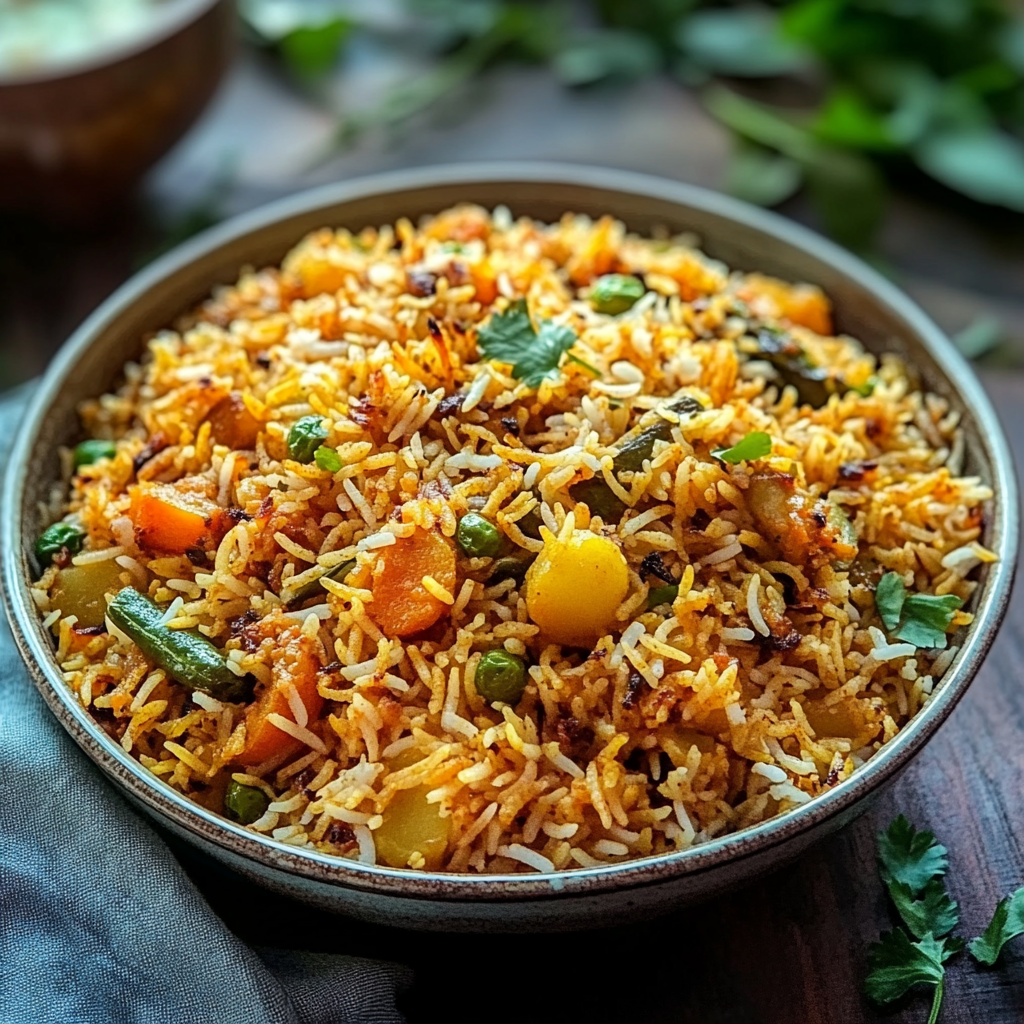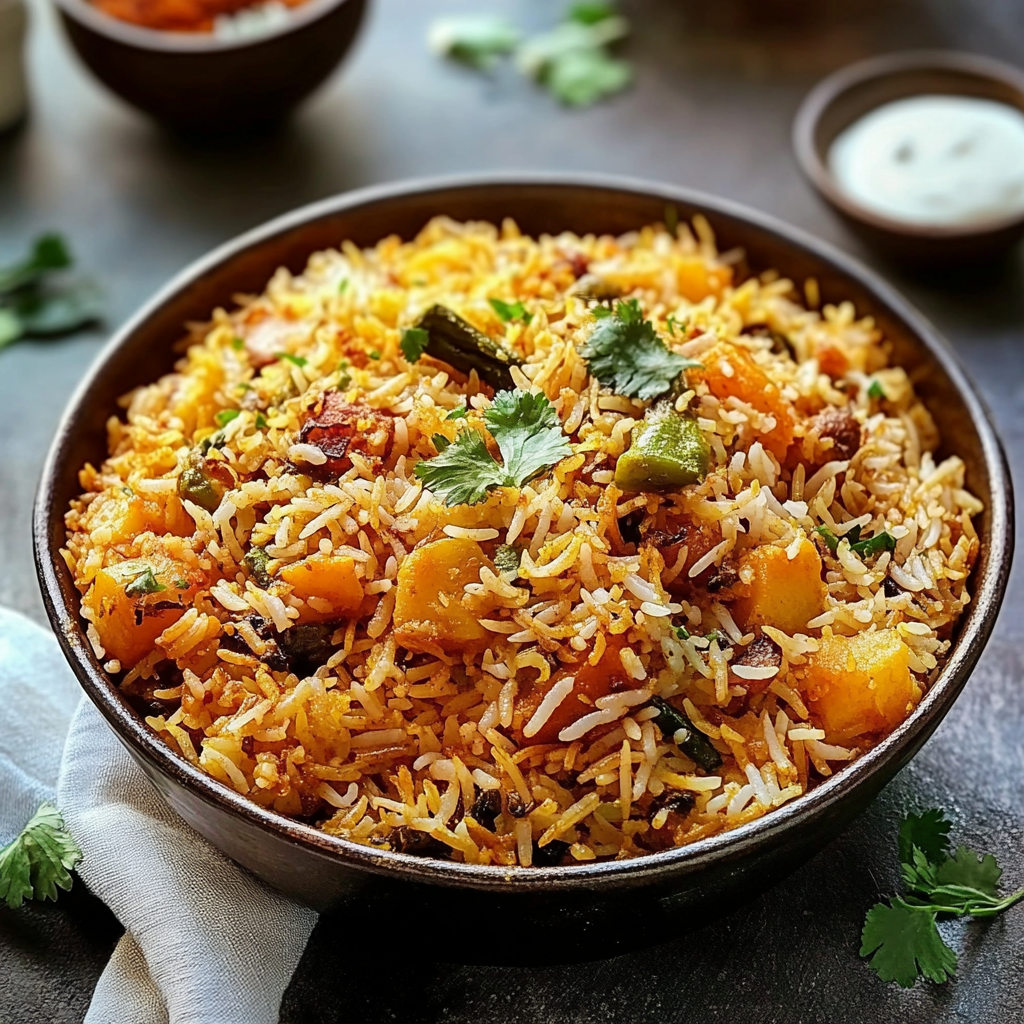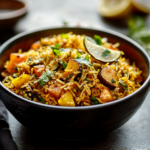Have you ever been enveloped by the captivating aroma of a freshly cooked pot of biryani? This fragrant dish, steeped in spices and layered with colorful vegetables, is not just a meal but an experience. The moment you lift the lid off the pot, a burst of steam escapes, carrying the enticing scent of cumin, cardamom, and saffron. Each grain of rice is fluffy and infused with flavor—it’s truly a feast for the senses.
Vegetable Biryani is perfect for any occasion—from family gatherings to festive celebrations. This one-pot wonder beautifully showcases seasonal vegetables amidst aromatic basmati rice. With its vibrant colors and rich flavors, it promises to be a showstopper at your dinner table. Not only does this dish tantalize your taste buds with every bite, but it also fills your home with warmth and joy as it cooks. Are you ready to create this delightful dish?
Why You’ll Love This Vegetable Biryani
- Flavor Explosion: Each bite bursts with a blend of spices that creates a symphony of flavors—perfectly balancing heat and richness.
- Healthy Ingredients: Packed with colorful vegetables and wholesome basmati rice, this dish provides essential nutrients and vitamins for a healthy meal.
- Versatile Meal: Whether enjoyed alone or paired with yogurt or raita, vegetable biryani adapts to various dietary preferences and occasions.
- Easy to Make: With simple steps and readily available ingredients, anyone can whip up this delicious dish in no time.

Ingredients for Vegetable Biryani
Here’s what you’ll need to make this delicious dish:
- Basmati Rice: This long-grain rice variety absorbs flavors beautifully; soak it for at least 30 minutes before cooking to achieve perfect fluffiness.
- Mixed Vegetables: Use fresh or frozen peas, carrots, bell peppers, and green beans for vibrant color and taste.
- Onions: Sliced thinly; sauté until golden brown for added depth of flavor.
- Garlic and Ginger Paste: Freshly made paste intensifies the flavor profile—use equal parts garlic and ginger for balance.
- Biryani Masala Powder: A blend of spices like cumin, coriander, turmeric, and garam masala; find pre-made mixes at stores or make your own.
- Saffron Strands: Soaked in warm water or milk; adds an aromatic touch and beautiful color to the biryani.
- Cilantro and Mint Leaves: Fresh herbs enhance the overall freshness; chop them coarsely before adding them into the mix.
The full ingredients list, including measurements, is provided in the recipe card directly below.
How to Make Vegetable Biryani
Follow these simple steps to prepare this delicious dish:
Step 1: Prepare the Rice
Begin by rinsing the basmati rice under cold water until the water runs clear. Soak it in plenty of water for about 30 minutes.
Step 2: Sauté Onions
Heat oil in a large pot over medium heat. Add sliced onions and cook until they turn golden brown. Stir often to prevent burning.
Step 3: Add Garlic-Ginger Paste
Stir in the garlic-ginger paste. Sauté for another minute until fragrant. This step builds a strong flavor base for your biryani.
Step 4: Incorporate Vegetables
Add mixed vegetables along with biryani masala powder. Mix well and cook for about five minutes until they soften slightly.
Step 5: Combine Rice
Drain soaked rice and add it to the pot. Gently stir everything together without breaking the grains of rice.
Step 6: Add Liquid & Cook
Pour in enough water (typically twice as much as rice) along with saffron-infused liquid. Bring it to a boil; then cover tightly and reduce heat to low. Cook for about 20 minutes until all liquid is absorbed.
Transfer to plates and garnish with fresh cilantro/mint leaves for an eye-catching presentation!

Tips and Tricks
Here are some helpful tips to ensure the best results for your dish:
- Soaking Rice: Always soak basmati rice beforehand; this helps achieve perfectly cooked grains that don’t stick together.
- Layering Flavors: For added depth, consider layering half-cooked rice over spiced vegetables before finishing cooking.
- Garnishing Options: Top your biryani with fried onions or cashews for extra crunch when serving.
Enjoy making this delightful Vegetable Biryani that not only nourishes but also brings people together around the dining table!
Mistakes to Avoid
- Overcooking the Rice
One common mistake when preparing Vegetable Biryani is overcooking the rice. It can lead to a mushy texture instead of the fluffy grains you desire. To achieve the perfect texture, always parboil the rice. This means cooking it until it’s about 70% done before layering it with the vegetables and spices. Remember to soak the rice for at least 30 minutes before cooking. This not only helps in achieving the right consistency but also enhances flavor absorption.
- Skipping Whole Spices
Many people make the error of omitting whole spices when making Vegetable Biryani. These spices, such as cardamom pods, cloves, and cinnamon sticks, add depth and complexity to your dish. Always toast them in oil before adding other ingredients; this releases their essential oils and enhances their flavors. Skipping this step can result in a bland biryani that lacks aromatic appeal. Invest in quality spices for a truly authentic taste.
- Not Using Enough Vegetables
A common mistake is not incorporating enough vegetables into your Vegetable Biryani. This dish should celebrate vibrant colors and textures from various vegetables like carrots, peas, and bell peppers. Aim for a good balance; too few vegetables can lead to an uninteresting meal. Choose seasonal veggies for freshness and variety, which also contributes to nutritional value. Experiment with different combinations to find what works best for you.
Ingredients
For a delicious Vegetable Biryani, gather the following ingredients:
– 2 cups basmati rice
– 1 cup mixed vegetables (carrots, peas, beans, and bell peppers)
– 1 large onion, thinly sliced
– 2 tomatoes, chopped
– 3 tablespoons vegetable oil or ghee
– 1 tablespoon ginger-garlic paste
– 1 teaspoon cumin seeds
– 1 bay leaf
– 4 green cardamom pods
– 4 cloves
– 1 stick cinnamon
– Salt to taste
– 1 teaspoon garam masala
– Fresh coriander leaves for garnish
Preparation Method
To prepare Vegetable Biryani, follow these simple steps:
Start by rinsing the basmati rice under cold water until the water runs clear. Soak it in water for about 30 minutes. In a large pot, heat the oil or ghee over medium heat. Add cumin seeds, bay leaf, cardamom pods, cloves, and cinnamon stick. Sauté for about a minute until fragrant.
Next, add the sliced onions and cook until they turn golden brown. Stir in ginger-garlic paste and chopped tomatoes. Continue cooking until the tomatoes soften. Then add the mixed vegetables and salt. Cook for an additional five minutes.
Once the vegetables are tender, drain the soaked rice and add it to the pot along with three cups of water. Bring everything to a boil. Cover the pot and reduce the heat to low. Let it simmer for about 20 minutes or until all water is absorbed.
Finally, sprinkle garam masala on top before serving. Gently fluff up the rice with a fork and garnish with fresh coriander leaves.
Serving Suggestions
This Vegetable Biryani is versatile and pairs wonderfully with:
- Raita: A cool yogurt side dish that complements the spices in biryani.
- Papad: Crispy lentil wafers that add texture to your meal.
- Salad: A fresh salad with cucumbers and tomatoes balances flavors perfectly.

FAQs
What is Vegetable Biryani?
Vegetable Biryani is a fragrant rice dish made with basmati rice, assorted vegetables, aromatic spices, and herbs. This delightful dish hails from Indian cuisine but has gained popularity worldwide due to its rich flavors and vibrant colors. The combination of spices such as cumin, garam masala, and cardamom enhances its taste significantly. Often served during special occasions or family gatherings, Vegetable Biryani appeals to both vegetarian and non-vegetarian palates alike.
Can I use any type of rice for Vegetable Biryani?
While basmati rice is traditionally used for Vegetable Biryani due to its long grains and unique aroma, you can substitute it with other types of rice if necessary. However, keep in mind that using non-basmati varieties may alter the texture and flavor of the final dish. If you opt for jasmine or long-grain rice instead, adjust your cooking time accordingly as these types often cook faster than basmati.
How can I make my Vegetable Biryani spicier?
To enhance the spice level of your Vegetable Biryani, you can include extra green chilies or red chili powder according to your taste preferences. Additionally, adding a pinch of cayenne pepper or using spicy mixed vegetables will elevate its heat without overpowering other flavors. Remember to balance spiciness with cooling side dishes like raita to make every bite enjoyable.
Can I prepare Vegetable Biryani in advance?
Absolutely! Preparing Vegetable Biryani in advance is not only possible but can also enhance its flavors as it sits. After cooking it completely, allow it to cool down before storing it in an airtight container in the refrigerator. Reheat gently on low heat before serving again while adding a splash of water if needed to ensure moisture retention.
Conclusion for Vegetable Biryani
In summary, Vegetable Biryani is a delightful dish combining aromatic basmati rice with colorful vegetables and spices. It is easy to prepare at home with readily available ingredients while offering an explosion of flavors in every bite. Serve alongside raita or salad for a complete meal experience. Whether you’re hosting a family gathering or enjoying a cozy dinner at home, this recipe promises satisfaction for everyone at your table. Embrace this flavorful journey through spices today!

Delicious Vegetable Biryani Recipe
- Total Time: 45 minutes
- Yield: Serves approximately 4
Description
Vegetable Biryani is a vibrant and aromatic dish that beautifully combines fluffy basmati rice with a colorful array of mixed vegetables and a rich blend of spices. This one-pot wonder is perfect for any occasion, whether it’s a festive celebration or a cozy family dinner. Each bite delivers an explosion of flavors, making it not just a meal but a delightful experience. The enticing aroma wafting from the pot fills your home with warmth and joy as you prepare this easy-to-make recipe. Embrace the deliciousness of Vegetable Biryani and enjoy the harmony of spices and textures that will leave everyone asking for seconds.
Ingredients
- 2 cups basmati rice
- 1 cup mixed vegetables (carrots, peas, beans, bell peppers)
- 1 large onion, thinly sliced
- 2 tomatoes, chopped
- 3 tablespoons vegetable oil or ghee
- 1 tablespoon ginger-garlic paste
- 1 teaspoon cumin seeds
- 1 bay leaf
- 4 green cardamom pods
- 4 cloves
- 1 stick cinnamon
- Salt to taste
- 1 teaspoon garam masala
- Fresh coriander leaves for garnish
Instructions
- Rinse basmati rice under cold water until clear; soak for 30 minutes.
- Heat oil or ghee in a large pot; add cumin seeds, bay leaf, cardamom pods, cloves, and cinnamon stick. Sauté for one minute until fragrant.
- Add sliced onions; cook until golden brown.
- Stir in ginger-garlic paste and chopped tomatoes; cook until tomatoes soften.
- Add mixed vegetables and salt; cook for five more minutes.
- Drain soaked rice and add to the pot with three cups of water; bring to a boil.
- Cover pot, reduce heat to low, and simmer for about 20 minutes or until water is absorbed.
- Sprinkle garam masala on top before serving; fluff rice gently with a fork and garnish with fresh coriander.
- Prep Time: 15 minutes
- Cook Time: 30 minutes
- Category: Main
- Method: Cooking
- Cuisine: Indian
Nutrition
- Serving Size: 1 cup (200g)
- Calories: 280
- Sugar: 4g
- Sodium: 500mg
- Fat: 10g
- Saturated Fat: 2g
- Unsaturated Fat: 8g
- Trans Fat: 0g
- Carbohydrates: 42g
- Fiber: 5g
- Protein: 6g
- Cholesterol: 0mg

